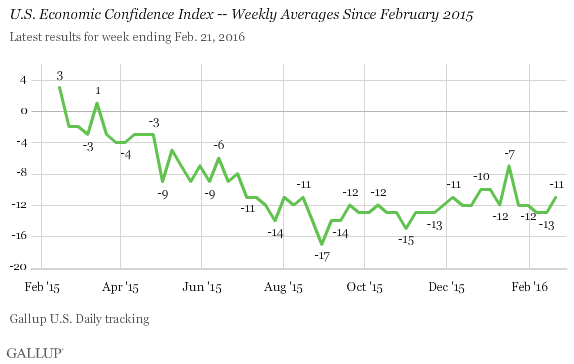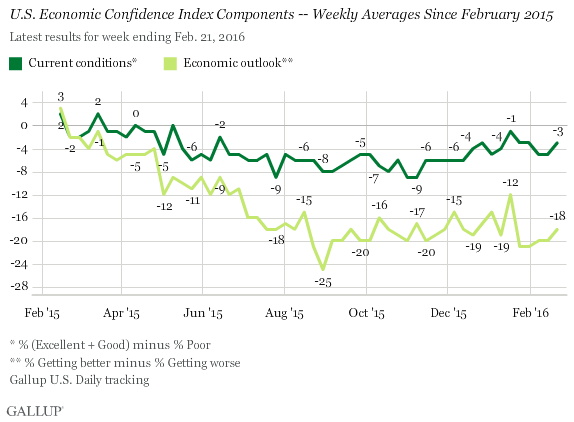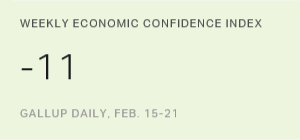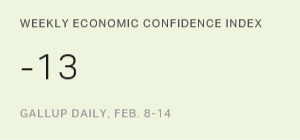Story Highlights
- Index has been between -10 and -15 most weeks since September
- Economic outlook score still trails current conditions score
WASHINGTON, D.C. -- Americans' views of the U.S. economy's strength remain largely unchanged since September, with the public continuing to evaluate the economy more negatively than positively. Gallup's U.S. Economic Confidence Index averaged -11 for the week ending Feb. 21, in line with most weekly averages since last fall.

The U.S. Economic Confidence Index was slightly more positive than negative in January and February 2015. However, confidence fell in the spring and summer after gas prices slightly increased and as international markets grew volatile. The index held firmly in negative territory, reaching a 2015 low score of -17 in late August. Since then, confidence -- while negative -- has stabilized. Index scores have ranged between -10 and -15 in recent months, apart from a slightly higher reading of -7 in late January after President Barack Obama's last State of the Union address.
Still, Americans' confidence in the economy remains greater than it was during the Great Recession and immediate post-recession years, from 2008 to 2011.
Gallup's U.S. Economic Confidence Index is the average of two components: how Americans rate current economic conditions and whether they feel the economy is improving or getting worse. Since March 2015, Americans' outlook for the economy has scored more negatively than their view of current conditions. Both components, however, have been fairly steady since the beginning of September, and the most recent readings are no exception.

For the week ending Feb. 21, 25% of U.S. adults rated the economy as "excellent" or "good," while 28% rated it as "poor." This resulted in a current conditions score of -3. The economic outlook score was -18, based on 39% saying the economy is "getting better" and 57% saying it is "getting worse."
Americans' evaluations of the U.S. economy in recent months remain negative, but stable. Americans are likely accustomed to the current state of the economy -- with its low gas prices, low unemployment with modest job growth, tempered economic growth in the fourth quarter of 2015 and stock market volatility in early 2016. Though there have been marginal changes to some of these key economic indicators in recent months, nothing has altered Americans' mildly negative economic mindset.
These data are available in Gallup Analytics.
Survey Methods
Results for this Gallup poll are based on telephone interviews conducted Feb. 15-21, 2016, on the Gallup U.S. Daily survey, with a random sample of 3,540 adults, aged 18 and older, living in all 50 U.S. states and the District of Columbia. For results based on the total sample of national adults, the margin of sampling error is ±2 percentage points at the 95% confidence level. All reported margins of sampling error include computed design effects for weighting.
Each sample of national adults includes a minimum quota of 60% cellphone respondents and 40% landline respondents, with additional minimum quotas by time zone within region. Landline and cellular telephone numbers are selected using random-digit-dial methods.
Learn more about how Gallup Daily tracking works.



